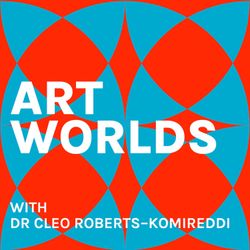Latest episode

40. Art Worlds: London Special
30:00||Season 5, Ep. 40This special edition of Art Worlds comes to you from London during the week of Frieze art fair. Cecilia Brunson is a London-based, originally from Chile, gallerist and advisor who has dedicated over two decades to championing Latin American art on a global stage. Beginning her career as a curator in America and then founding a residency programme in Santiago, her move to London in 2009 led her to establish Cecilia Brunson Projects in Bermondsey. The gallery, which is attached to her home, has become a beacon for Latin American art in the capital. Cecilia has uncovered overlooked Latin American artists’ estates and supported contemporary talent from the region, often introducing artists that have never been shown before in Europe. She joined me from her gallery to discuss the artists she’ll be exhibiting at Frieze and in her space.
More episodes
View all episodes

39. Art Worlds: London Special
27:10||Season 5, Ep. 39This special edition of Art Worlds comes to you from London during the week of Frieze art fair.Reena Saini Kallat is an artist based in India’s economic capital, Mumbai. Central to her practice, which spans drawing, photography, sculpture and video, are the often man-made tensions and divisions that mark our existence. As such, she has explored political borders like the Radcliff Line, investigated water treaties as well as researching divisive national rhetoric. In all her investigations, Reena likes to highlight areas of subversion and show the ways in which systems of authority can be malleable and overcome. Reena is showing one of her impressive listening device sculptures at Frieze Sculpture curated by Fatoş Üstek. Installed in the grounds of Regent’s Park, her work is interactive and uses sound to invite audiences to dwell on themes of loss, violence and protection. Reena joined me from her studio just after she had returned from London and the sculpture park’s opening.
38. Art Worlds: Bolivia
23:34||Season 4, Ep. 38Episode 38 features Raquel Schwartz, an artist and director of Kiosko Galería, an independent art space in Bolivia’s largest city, Santa Cruz de la Sierra. On its site you’ll find exhibition galleries, a library, a communal studio area, shop and residency spaces. With thoughtful programming, including practical workshops, performances and history of art talks, Kiosko is a place where Bolivia’s arts community gravitate. Raquel has a clear focus on using art to contribute to society. She founded her eponymous foundation with the intention of supporting projects that raise awareness of Bolivia’s social and environmental challenges. Raquel spoke to me just after concluding an ambitious 12 day micro-residency in the foothills of the Bolivian Andes.
37. Art Worlds: Bolivia
31:32||Season 4, Ep. 37Kenia Almaraz Murillo is an artist who seamlessly blends and balances references to her diasporic experiences. Born in Bolivia and now living in Paris, she creates wall-mounted sculptures that are hand woven from Bolivian yarns and antique French thread which often incorporate found urban objects and luminous LED lights. The effect is majestic and not only draws on but also honours the spirituality associated with her Andean ancestors.Rituals are strongly evoked by Kenia’s works. At times she has integrated protective amulets and offerings, like corn blessed by shamans, into her weaving. She has also produced a temple-like room of sculptures that reference the animals significant in Andean cosmology. Kenia spoke to me from her Parisian studio about her evolving exploration of Bolivian culture.
36. Art Worlds: Madagascar
22:44||Season 4, Ep. 36Episode 36 features Tsiriniaina Hajatiana Irimboangy, an artist-designer and researcher based between Madagascar and France. From their background in graphic design, their practice uses digital creation technologies, including AI and 3D digitisation, to highlight, preserve and give a voice to Malagasy heritage and culture. Within this framework, Tsiriniaina often seeks out stories that have been overlooked and marginalised and uses their transmedia approach to refocus attention. Tsiriniaina was the winner of Fondation H’s Prix Pari-tana in 2024 and used the awarded residency, at the Cité Internationale des Arts in Paris, to develop their project 'Ridô - Revealing memories'. Tsiriniaina joined me from Antananarivo in Madagascar where they were working on a new exhibition.
35. Art Worlds: Madagascar
29:16||Season 4, Ep. 35Episode 35 features Joël Andrianomearisoa, an artist who straddles worlds working and living between Paris and Magnat-l’Étrange in France as well as Antananarivo in Madagascar. His work, which encompasses sculpture, installation, performance, craft and textiles, is influenced by the cultural diversity that characterises Madagascar yet it speaks beyond here. A piece like ‘The Five Continents Of All Our Desires’, made from suspended sheets of black silk paper, considers the architecture of feelings and the way emotional experiences, like desire, can be considered universal. Joël has exhibited across the globe and was the artist chosen to represent Madagascar when the country first participated in the Venice Biennale in 2019. Since then he has created exhibition opportunities for Malagasy artists through the platform Hakanto Contemporary. Set in a sprawling warehouse in Antananarivo, the initiative celebrates and supports Malagasy creativity. Joël joined me from his studio in Paris and explained the ways he likes to provoke and bring people together.
34. Art Worlds: Madagascar
25:04||Season 4, Ep. 34Episode 34 speaks to Margaux Huille, director of Fondation H, a Malagasy organisation dedicated to contemporary art. Margaux has spent her career championing artists from Africa and its diaspora. Having helped launch the endowment fund African Artists for Development and worked with 1-54 Contemporary African Art Fair, she has been deeply embedded in the continent’s various art worlds. Fondation H, launched by patron Hassanein Hiridjee in 2017, operates in Madagascar’s capital, Antananarivo and France’s capital, Paris. From permanent spaces in both locations, the programming foregrounds the development and structuring of the Indian Ocean art scene. This is realised through supporting artists with exhibition opportunities, workshops and prizes as well as focusing on increasing public access to art. Margaux spoke to me from Antananarivo about the scope and value of these activities.